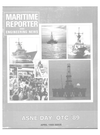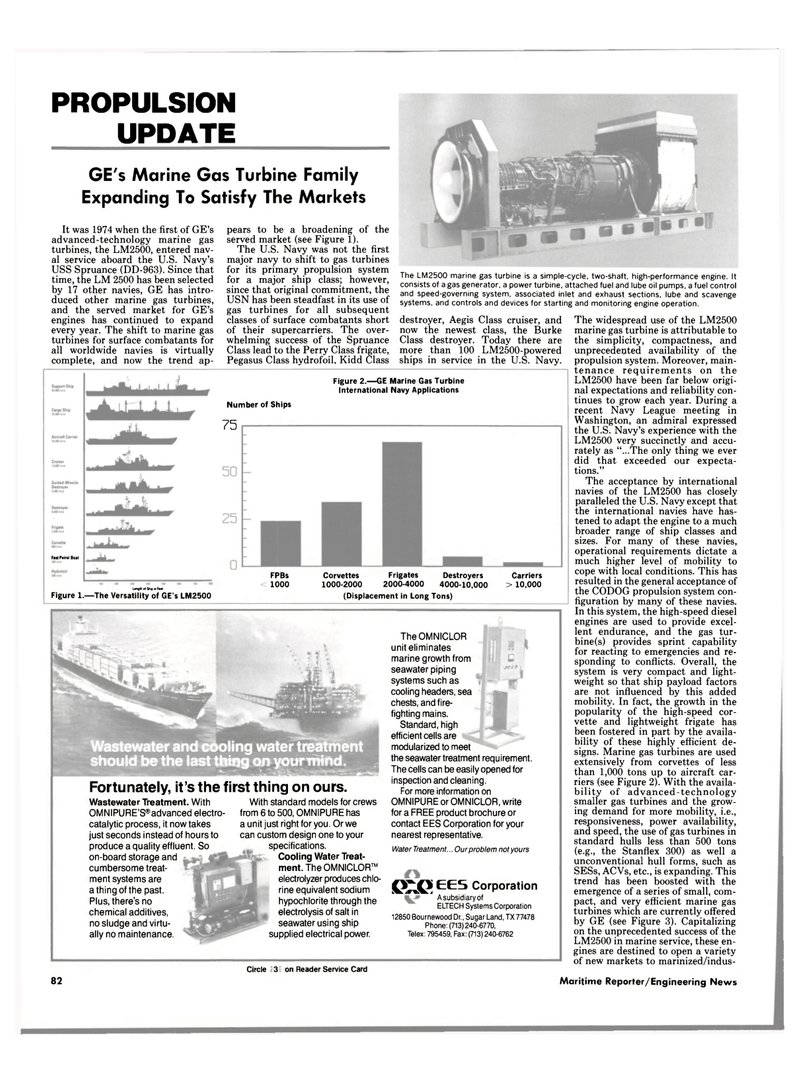
Page 80: of Maritime Reporter Magazine (April 1989)
Read this page in Pdf, Flash or Html5 edition of April 1989 Maritime Reporter Magazine
PROPULSION
UPDATE
GE's Marine Gas Turbine Family
Expanding To Satisfy The Markets
It was 1974 when the first of GE's advanced-technology marine gas turbines, the LM2500, entered nav- al service aboard the U.S. Navy's
USS Spruance (DD-963). Since that time, the LM 2500 has been selected by 17 other navies, GE has intro- duced other marine gas turbines, and the served market for GE's engines has continued to expand every year. The shift to marine gas turbines for surface combatants for all worldwide navies is virtually complete, and now the trend ap- pears to be a broadening of the served market (see Figure 1).
The U.S. Navy was not the first major navy to shift to gas turbines for its primary propulsion system for a major ship class; however, since that original commitment, the
USN has been steadfast in its use of gas turbines for all subsequent classes of surface combatants short of their supercarriers. The over- whelming success of the Spruance
Class lead to the Perry Class frigate,
Pegasus Class hydrofoil, Kidd Class
The LM2500 marine gas turbine is a simple-cycle, two-shaft, high-performance engine. It consists of a gas generator, a power turbine, attached fuel and lube oil pumps, a fuel control and speed-governing system, associated inlet and exhaust sections, lube and scavenge systems, and controls and devices for starting and monitoring engine operation. destroyer, Aegis Class cruiser, and now the newest class, the Burke
Class destroyer. Today there are more than 100 LM2500-powered ships in service in the U.S. Navy.
Fan Patrol Boat
Figure 2.—GE Marine Gas Turbine
International Navy Applications
Number of Ships 75
Length of Ship in F«»t
Figure 1.—The Versatility of GE's LM2500
FPBs Corvettes Frigates Destroyers 1000 1000-2000 2000-4000 4000-10,000 (Displacement in Long Tons)
Carriers > 10,000
Fortunately, it's the first thing on ours.
Wastewater Treatment. With
OMNIPURE'S®advanced electro- catalytic process, it now takes just seconds instead of hours to produce a quality effluent. So on-board storage and cumbersome treat- ment systems are a thing of the past.
Plus, there's no chemical additives, no sludge and virtu- ally no maintenance.
With standard models for crews from 6 to 500, OMNIPURE has a unit just right for you. Or we can custom design one to your specifications.
Cooling Water Treat- ment. The OMNICLOR™ electrolyzer produces chlo- rine equivalent sodium hypochlorite through the electrolysis of salt in seawater using ship supplied electrical power.
The OMNICLOR unit eliminates marine growth from seawater piping systems such as cooling headers, sea chests, and fire- fighting mains.
Standard, high efficient cells are modularized to meet the seawater treatment requirement.
The cells can be easily opened for inspection and cleaning.
For more information on
OMNIPURE or OMNICLOR, write for a FREE product brochure or contact EES Corporation for your nearest representative.
Water Treatment... Our problem not yours
Q Q EES Corporation
A subsidiary of
ELTECH Systems Corporation 12850 Bournewood Dr., Sugar Land, TX 77478
Phone:(713)240-6770,
Telex: 795459, Fax: (713) 240-6762
Circle 348 on Reader Service Card
The widespread use of the LM2500 marine gas turbine is attributable to the simplicity, compactness, and unprecedented availability of the propulsion system. Moreover, main- tenance requirements on the
LM2500 have been far below origi- nal expectations and reliability con- tinues to grow each year. During a recent Navy League meeting in
Washington, an admiral expressed the U.S. Navy's experience with the
LM2500 very succinctly and accu- rately as "...The only thing we ever did that exceeded our expecta- tions."
The acceptance by international navies of the LM2500 has closely paralleled the U.S. Navy except that the international navies have has- tened to adapt the engine to a much broader range of ship classes and sizes. For many of these navies, operational requirements dictate a much higher level of mobility to cope with local conditions. This has resulted in the general acceptance of the CODOG propulsion system con- figuration by many of these navies.
In this system, the high-speed diesel engines are used to provide excel- lent endurance, and the gas tur- bine(s) provides sprint capability for reacting to emergencies and re- sponding to conflicts. Overall, the system is very compact and light- weight so that ship payload factors are not influenced by this added mobility. In fact, the growth in the popularity of the high-speed cor- vette and lightweight frigate has been fostered in part by the availa- bility of these highly efficient de- signs. Marine gas turbines are used extensively from corvettes of less than 1,000 tons up to aircraft car- riers (see Figure 2). With the availa- bility of advanced-technology smaller gas turbines and the grow- ing demand for more mobility, i.e., responsiveness, power availability, and speed, the use of gas turbines in standard hulls less than 500 tons (e.g., the Stanflex 300) as well a unconventional hull forms, such as
SESs, ACVs, etc., is expanding. This trend has been boosted with the emergence of a series of small, com- pact, and very efficient marine gas turbines which are currently offered by GE (see Figure 3). Capitalizing on the unprecedented success of the
LM2500 in marine service, these en- gines are destined to open a variety of new markets to marinized/indus- 82 Maritime Reporter/Engineering News

 79
79

 81
81
